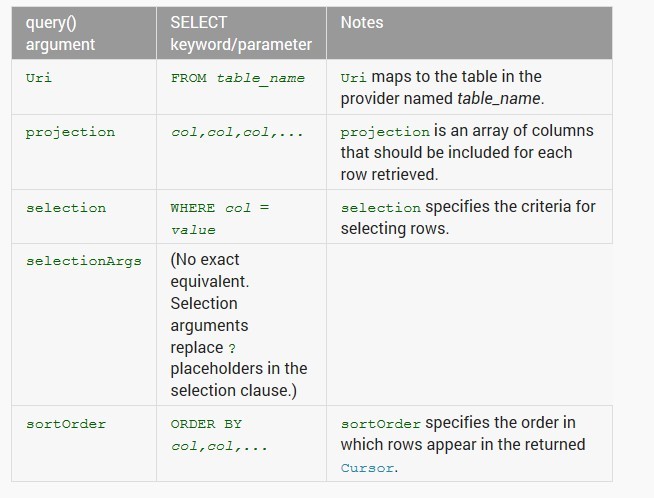Android四大组件之一ContentProvider(内容提供者)
2013-05-16 15:31
507 查看
ContentProvider为存储和获取数据提供了统一的接口。ContentProvide对数据进行封装,不用关心数据存储的细节,虽然使用其他方法也可以对外共享数据,但数据访问方式
使用ContentProvider可以在不同的应用程序之间共享数据。Android为常见的一些数据提供了默认的ContentProvider(包括音频、视频、图片和通讯录等)。ContentProvider所提供的函数:query(),insert(),update(),delete(),getType(),onCreate()等。
For example, to get a list of the words and their locales from the User Dictionary Provider, you call
ContentResolver.query().
The
query()method calls the
ContentProvider.query()
method defined by the User Dictionary Provider. The following lines of code show a
ContentResolver.query()
call:
// Queries the user dictionary and returns results mCursor = getContentResolver().query( UserDictionary.Words.CONTENT_URI, // The content URI of the words table mProjection, // The columns to return for each row mSelectionClause // Selection criteria mSelectionArgs, // Selection criteria mSortOrder); // The sort order for the returned rows
Table 2 shows how the arguments to
query(Uri,projection,selection,selectionArgs,sortOrder)
match an SQL SELECT statement:
在Content Provider中使用的查询字符串有别于标准的SQL查询。
Table 2: Query() compared to SQL query.

URI:
A content URI is a URI that identifies data in a provider. Content URIs include the symbolic name of the entire provider (itsauthority) and a name that points to a table (apath).
When you call a client method to access a table in a provider, the content URI for the table is one of the arguments.
In the preceding lines of code, the constant
CONTENT_URIcontains the content URI of the user dictionary's "words" table. The
ContentResolver
object parses out the URI's authority, and uses it to "resolve" the provider by comparing the authority to a system table of known providers. The
ContentResolver
can then dispatch the query arguments to the correct provider.
The
ContentProvideruses the path part of the content URI to choose the table to access. A provider usually has apath for each
table it exposes.
In the previous lines of code, the full URI for the "words" table is:
content://user_dictionary/words
where the
user_dictionarystring is the provider's authority, and
wordsstring is the table's path. The string
content://(thescheme) is always present, and identifies this as a content URI.
Many providers allow you to access a single row in a table by appending an ID value to the end of the URI. For example, to retrieve a row whose
_IDis
4from user dictionary, you can use this content URI:
Uri singleUri = ContentUris.withAppendedId(UserDictionary.Words.CONTENT_URI,4);
Inserting, Updating, and Deleting Data
Inserting data
To insert data into a provider, you call theContentResolver.insert()method. This method
inserts a new row into the provider and returns a content URI for that row. This snippet shows how to insert a new word into the User Dictionary Provider:
// Defines a new Uri object that receives the result of the insertion Uri mNewUri; ... // Defines an object to contain the new values to insert ContentValues mNewValues = new ContentValues(); /* * Sets the values of each column and inserts the word. The arguments to the "put" * method are "column name" and "value" */ mNewValues.put(UserDictionary.Words.APP_ID, "example.user"); mNewValues.put(UserDictionary.Words.LOCALE, "en_US"); mNewValues.put(UserDictionary.Words.WORD, "insert"); mNewValues.put(UserDictionary.Words.FREQUENCY, "100"); mNewUri = getContentResolver().insert( UserDictionary.Word.CONTENT_URI, // the user dictionary content URI mNewValues // the values to insert );
Updating data
To update a row, you use aContentValuesobject with the updated values just as you do with an insertion, and selection criteria just as you do with
a query. The client method you use is
ContentResolver.update().
You only need to add values to the
ContentValuesobject for columns you're updating. If you want to clear the contents of a column, set the value to
null.
The following snippet changes all the rows whose locale has the language "en" to a have a locale of
null. The return value is the number of rows that were updated:
// Defines an object to contain the updated values
ContentValues mUpdateValues = new ContentValues();
// Defines selection criteria for the rows you want to update
String mSelectionClause = UserDictionary.Words.LOCALE + "LIKE ?";
String[] mSelectionArgs = {"en_%"};
// Defines a variable to contain the number of updated rows
int mRowsUpdated = 0;
...
/* * Sets the updated value and updates the selected words. */
mUpdateValues.putNull(UserDictionary.Words.LOCALE);
mRowsUpdated = getContentResolver().update(
UserDictionary.Words.CONTENT_URI, // the user dictionary content URI
mUpdateValues // the columns to update
mSelectionClause // the column to select on
mSelectionArgs // the value to compare to
);The data for the new row goes into a single
ContentValuesobject, which is similar in form to a one-row cursor. The columns in this object don't need
to have the same data type, and if you don't want to specify a value at all, you can set a column to
nullusing
ContentValues.putNull().
The snippet doesn't add the
_IDcolumn, because this column is maintained automatically. The provider assigns a unique value of
_IDto every row that is added. Providers usually use this value as the table's primary key.
The content URI returned in
newUriidentifies the newly-added row, with the following format:
content://user_dictionary/words/<id_value>
The
<id_value>is the contents of
_IDfor the new row. Most providers can detect this form of content URI automatically and then perform the requested operation on that particular row.
To get the value of
_IDfrom the returned
Uri, call
ContentUris.parseId().
Deleting data
Deleting rows is similar to retrieving row data: you specify selection criteria for the rows you want to delete and the client method returns the number of deleted rows. The following snippet deletes rows whose appid matches "user". The methodreturns the number of deleted rows.
// Defines selection criteria for the rows you want to delete
String mSelectionClause = UserDictionary.Words.APP_ID + " LIKE ?";
String[] mSelectionArgs = {"user"};
// Defines a variable to contain the number of rows deleted
int mRowsDeleted = 0;
...
// Deletes the words that match the selection criteria
mRowsDeleted = getContentResolver().delete(
UserDictionary.Words.CONTENT_URI, // the user dictionary content URI
mSelectionClause // the column to select on
mSelectionArgs // the value to compare to
);相关文章推荐
- Android四大组件之内容提供者ContentProvider
- Android 四大组件之一 :ContentProvider内容提供者从入门到精通
- Android之四大组件之一-ContentProvider内容提供者的使用(二)
- android四大组件之一内容提供者contentprovider
- Android四大组件之ContentProvider(内容提供者)01
- Android四大组件之一ContentProvider内容提供者(继SQLite数据存储篇)
- Android四大组件之ContentProvider(内容提供者)02
- Android基础之四大组件-ContentProvider(内容提供者)
- Android四大组件之ContentProvider(内容提供者)
- Android四大组件之一之内容提供者ContentProvider
- android 四大应用主键之 --- ContentProvider (内容提供者)
- 四大组件之内容提供者——ContentProvider
- Android之四大组件之一-Content Provider内容提供者的介绍(一)
- Android组件之ContentProvider(内容提供者)
- Android四大基本组件(2)之Service 服务与Content Provider内容提供者
- Android四大组件ContentProvider 内容提供者
- Android四大组件之内容提供者--ContentProvider
- Android四大组件之ContentProvide(内容提供者)
- Android四大组件之内容提供者
- 【Android学习之道】 四大组件之ContentProvider内容提供器
